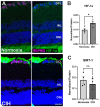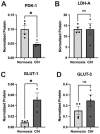Ocular Inflammation and Oxidative Stress as a Result of Chronic Intermittent Hypoxia: A Rat Model of Sleep Apnea
- PMID: 39061946
- PMCID: PMC11273423
- DOI: 10.3390/antiox13070878
Ocular Inflammation and Oxidative Stress as a Result of Chronic Intermittent Hypoxia: A Rat Model of Sleep Apnea
Abstract
Obstructive sleep apnea (OSA) is a sleep disorder characterized by intermittent complete or partial occlusion of the airway. Despite a recognized association between OSA and glaucoma, the nature of the underlying link remains unclear. In this study, we investigated whether mild OSA induces morphological, inflammatory, and metabolic changes in the retina resembling those seen in glaucoma using a rat model of OSA known as chronic intermittent hypoxia (CIH). Rats were randomly assigned to either normoxic or CIH groups. The CIH group was exposed to periodic hypoxia during its sleep phase with oxygen reduction from 21% to 10% and reoxygenation in 6 min cycles over 8 h/day. The eyes were subsequently enucleated, and then the retinas were evaluated for retinal ganglion cell number, oxidative stress, inflammatory markers, metabolic changes, and hypoxic response modulation using immunohistochemistry, multiplex assays, and capillary electrophoresis. Statistically significant differences were observed between normoxic and CIH groups for oxidative stress and inflammation, with CIH resulting in increased HIF-1α protein levels, higher oxidative stress marker 8-OHdG, and increased TNF-α. Pyruvate dehydrogenase kinase-1 protein was significantly reduced with CIH. No significant differences were found in retinal ganglion cell number. Our findings suggest that CIH induces oxidative stress, inflammation, and upregulation of HIF-1α in the retina, akin to early-stage glaucoma.
Keywords: chronic intermittent hypoxia; glaucoma; inflammation; obstructive sleep apnea; oxidative stress.
Conflict of interest statement
The authors declare no conflicts of interest.
Figures







Similar articles
-
Sex-dependent effects of chronic intermittent hypoxia: implication for obstructive sleep apnea.Biol Sex Differ. 2024 Apr 25;15(1):38. doi: 10.1186/s13293-024-00613-3. Biol Sex Differ. 2024. PMID: 38664845 Free PMC article.
-
The impact of chronic intermittent hypoxia on enzymatic activity in memory-associated brain regions of male and female rats.Biol Sex Differ. 2025 Jan 31;16(1):5. doi: 10.1186/s13293-025-00688-6. Biol Sex Differ. 2025. PMID: 39891225 Free PMC article.
-
Down-regulation of vascular PPAR-γ contributes to endothelial dysfunction in high-fat diet-induced obese mice exposed to chronic intermittent hypoxia.Biochem Biophys Res Commun. 2017 Oct 14;492(2):243-248. doi: 10.1016/j.bbrc.2017.08.058. Epub 2017 Aug 16. Biochem Biophys Res Commun. 2017. PMID: 28822761
-
Role of Carotid Body in Intermittent Hypoxia-Related Hypertension.Curr Hypertens Rep. 2017 May;19(5):38. doi: 10.1007/s11906-017-0735-0. Curr Hypertens Rep. 2017. PMID: 28451849 Review.
-
Obstructive sleep apnea and chronic intermittent hypoxia: a review.Chin J Physiol. 2006 Oct 31;49(5):234-43. Chin J Physiol. 2006. PMID: 17294831 Review.
Cited by
-
Association and risk factors analysis of FeNO and CRP in bronchial asthma combined with obstructive sleep apnea.Front Med (Lausanne). 2025 Jun 30;12:1546389. doi: 10.3389/fmed.2025.1546389. eCollection 2025. Front Med (Lausanne). 2025. PMID: 40662069 Free PMC article. Review.
-
Neuro-Ophthalmological Disorders Associated with Obstructive Sleep Apnoea.Int J Mol Sci. 2025 Jul 11;26(14):6649. doi: 10.3390/ijms26146649. Int J Mol Sci. 2025. PMID: 40724899 Free PMC article. Review.
-
Reversing Aging and Improving Health Span in Glaucoma Patients: The Next Frontier?J Curr Glaucoma Pract. 2024 Jul-Sep;18(3):87-93. doi: 10.5005/jp-journals-10078-1451. Epub 2024 Oct 29. J Curr Glaucoma Pract. 2024. PMID: 39575133 Free PMC article.
-
Anti-TNFα and Anti-IL-1β Monoclonal Antibodies Preserve BV-2 Microglial Homeostasis Under Hypoxia by Mitigating Inflammatory Reactivity and ATF4/MAPK-Mediated Apoptosis.Antioxidants (Basel). 2025 Mar 19;14(3):363. doi: 10.3390/antiox14030363. Antioxidants (Basel). 2025. PMID: 40338234 Free PMC article.
-
Changes in the Spatial Structure of Synchronization Connections in EEG During Nocturnal Sleep Apnea.Clocks Sleep. 2024 Dec 31;7(1):1. doi: 10.3390/clockssleep7010001. Clocks Sleep. 2024. PMID: 39846529 Free PMC article.
References
-
- Sheybani A., Scott R., Samuelson T.W., Kahook M.Y., Bettis D.I., Ahmed I.I.K., Stephens J.D., Kent D., Ferguson T.J., Herndon L.W. Open-Angle Glaucoma: Burden of Illness, Current Therapies, and the Management of Nocturnal IOP Variation. Ophthalmol. Ther. 2020;9:1–14. doi: 10.1007/s40123-019-00222-z. - DOI - PMC - PubMed
Grants and funding
LinkOut - more resources
Full Text Sources

